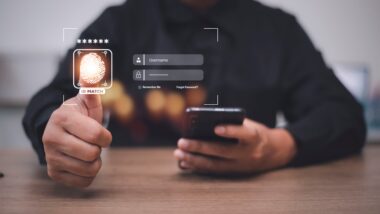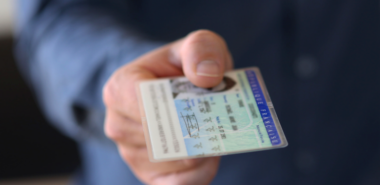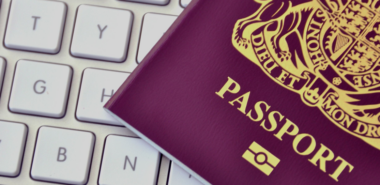
If you’re a fan of science-fiction or action movies, you’ll have seen lots of scenes involving facial recognition. Plots revolve around how characters open security doors and try to escape being identified on camera. it’s probably technology you wouldn’t think you’d use in your everyday travels. But actually, it’s already here and it is highly accurate. If you or your friend has an iPhone X you’ll be familiar with Face ID. But what if I told you facial recognition was now playing a major role in travel and border control?
In this post I’m going to start our rundown of 10 buzzwords related to facial recognition. By the time you’ve finished reading, you’ll be an expert.
The field isn’t as complicated as you think, so without further ado, let’s begin!
#1 Electronic Passport
Over 1 billion passports are biometric today, meaning they contain at least the holder’s portrait securely stored in a contactless chip. This picture, as well as the biographic information, is in a standard format defined by the International Civil Aviation Organization (ICAO). This is accessible to border control agents and self-service systems such as Automatic Border Control (ABC) gates.
The ICAO 9303 specification does not specify the exact size of the jpeg portrait but considers 12kB a minimum for reliable facial recognition, and 15-20kB as optimum.
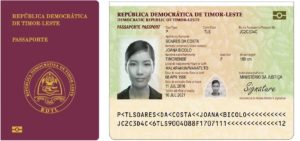
Here you can see that the biometric passport has an embedded chip that is also contactless. This microprocessor in your passport is why it’s called an electronic passport, or more commonly an ePassport.
This contactless chip is the key to help you secure and prove your identity, as well as to help you get through border control swiftly.
This microprocessor securely stores the information that you can see on your passport photo page: your name, place of birth, date of issue, validity, passport number and your picture too.
This information can be retrieved and verified by an agent using a passport reader or by inserting your passport into a gate or kiosk reader. The document reader will scan the graphical information and passport security features as well as retrieve the data and certificates stored into the chip.
This is extremely powerful, both in terms of security and facilitation.
It means that in seconds:
- Your document can be verified as genuine
- You are certified as the rightful owner of that document.
#2 Automated Border Control (ABC) Gate
At border control, the check is performed either by the officer comparing your face to the picture of the passport, or automatically by a camera-enabled system.
This is what happens in an Automated Border Control (ABC) Gate, where an automatic capture of your face is compared to the photo on your document.
But did you know that the ABC Gate does not scan your photo on the passport page, but instead reads the data stored on the contactless chip?
That’s to ensure that any physical blemishes to the passport page (such as scratches, any fading over the years) cannot confuse the gate, and that the document has not been altered or fraudulently issued from a valid blank document.
Now that we have covered the basics of what biometric documents and readers are, let’s get into the technology.
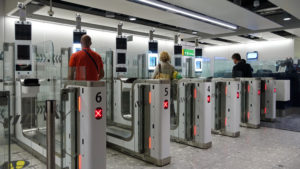
#3 Live Facial Recognition Systems
Facial recognition systems are already being used on a massive scale to electronically identify people as they walk past a camera. And unlike fingerprints or iris scans, they can be done at a distance.
A security camera will be able to scan faces from greater distances, compared to a camera built inside an ABC gate or a kiosk. These require the person to be maximum of 1 or 2 meters away.
The bigger the distance from the faces to scan, the more complex the system will be.
If the camera is far away, the system will have to search for faces and isolate them from the crowd. Then, it will likely have to tilt, stretch, distort and re-orient them before being able to locate the facial features and align them for accurate measurement. Then the conversion to facial features can happen.
So, how does a professional facial recognition system work?
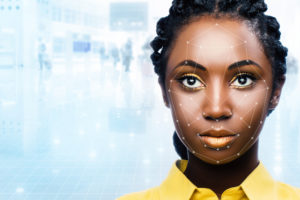
#4 Not a picture, but a Faceprint
From the captured photo, facial recognition systems generate a faceprint which is unique to a single individual. The unique face print is a data set generated through code, from precise measures such as the distance between the eyes, the length of the jaw line, the width of the nose etc.
A facial recognition system will typically check between 75 to 85 points in a face to build a face print or pattern. This face print can then be used to search through a biometric data base for matches.
Creating a faceprint, in other words a digitally recorded representation of a person’s face, is a good solution to avoid storing images. This allows for greater security and privacy as it maps an individual’s facial features mathematically and no longer a visible portrait.
A biometric recognition system can run in two different modes: verification or identification.
- Verification is when you want to check that the person is the correct one. For the system to assess this, the person will have to know or show something. In the case of a border check, the information on a passport is compared with the image of a person standing in front of the camera. The system only has to check one biometric profile, so this is called one to one or 1:1 matching.
- Identification is when you are trying to determine who the person is. Here the system will have to find an unknown person by comparing him or her to a dataset, check the biometrics against all the others in the reference database such as a watch list. This is known as one to many or 1:N matching.
Verification is what is done in ABC gate systems for instance. In this case, the person’s identity is confirmed by comparing the pattern created during live capture and verifying that against the picture contained in the document or a template stored in a database.
If it’s all automated, how is accuracy insured?
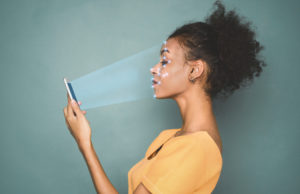
#5 Facial Recognition Rate
Why would facial biometrics not be accurate?
The technical challenges of automated recognition of individuals based on their biological characteristics are inherent to the transformation of analog (facial image, fingerprint, voice pattern…) to digital information (faceprint, minutiae) that can then be processed and compared/matched with effective algorithms.
We measure the accuracy of a facial recognition system according to its Recognition Rate or verification rate. The Verification Rate relies on a list of image pairs. This rate is relevant in 1:1 systems such as ABC gates.
The Recognition Rate (RR) is the total number of correctly identified probe images, divided by the total number of probe images. This is the rate used for identification systems.
So let’s say 9 faces out of 10 are recognized by your system. Your RR would be 90%. Of course, you’ll need to use some large benchmark databases for credible results.
The accuracy of the system is related to the algorithm used by the system. It detects a face and compares it to a data set of many images of one person and many images of different people.
The accuracy and performance of the algorithm are related to its learning capacity, meaning that you have to train the algorithm on a set of images of the same person as well as multiple images of other people.
So the size of the data set is very important: the larger the data set, the more you can train your algorithm and gain in accuracy.
That’s it for the first part of our guide into the buzzwords floating around about facial recognition. You can read about the remaining five terms here. If you have any questions so far, be sure to get in touch in the comments below or @Gemalto.
